Bardh Prenkaj
CURE: Controlled Unlearning for Robust Embeddings -- Mitigating Conceptual Shortcuts in Pre-Trained Language Models
Sep 05, 2025Abstract:Pre-trained language models have achieved remarkable success across diverse applications but remain susceptible to spurious, concept-driven correlations that impair robustness and fairness. In this work, we introduce CURE, a novel and lightweight framework that systematically disentangles and suppresses conceptual shortcuts while preserving essential content information. Our method first extracts concept-irrelevant representations via a dedicated content extractor reinforced by a reversal network, ensuring minimal loss of task-relevant information. A subsequent controllable debiasing module employs contrastive learning to finely adjust the influence of residual conceptual cues, enabling the model to either diminish harmful biases or harness beneficial correlations as appropriate for the target task. Evaluated on the IMDB and Yelp datasets using three pre-trained architectures, CURE achieves an absolute improvement of +10 points in F1 score on IMDB and +2 points on Yelp, while introducing minimal computational overhead. Our approach establishes a flexible, unsupervised blueprint for combating conceptual biases, paving the way for more reliable and fair language understanding systems.
Probabilistic Aggregation and Targeted Embedding Optimization for Collective Moral Reasoning in Large Language Models
Jun 18, 2025Abstract:Large Language Models (LLMs) have shown impressive moral reasoning abilities. Yet they often diverge when confronted with complex, multi-factor moral dilemmas. To address these discrepancies, we propose a framework that synthesizes multiple LLMs' moral judgments into a collectively formulated moral judgment, realigning models that deviate significantly from this consensus. Our aggregation mechanism fuses continuous moral acceptability scores (beyond binary labels) into a collective probability, weighting contributions by model reliability. For misaligned models, a targeted embedding-optimization procedure fine-tunes token embeddings for moral philosophical theories, minimizing JS divergence to the consensus while preserving semantic integrity. Experiments on a large-scale social moral dilemma dataset show our approach builds robust consensus and improves individual model fidelity. These findings highlight the value of data-driven moral alignment across multiple models and its potential for safer, more consistent AI systems.
SCISSOR: Mitigating Semantic Bias through Cluster-Aware Siamese Networks for Robust Classification
Jun 17, 2025Abstract:Shortcut learning undermines model generalization to out-of-distribution data. While the literature attributes shortcuts to biases in superficial features, we show that imbalances in the semantic distribution of sample embeddings induce spurious semantic correlations, compromising model robustness. To address this issue, we propose SCISSOR (Semantic Cluster Intervention for Suppressing ShORtcut), a Siamese network-based debiasing approach that remaps the semantic space by discouraging latent clusters exploited as shortcuts. Unlike prior data-debiasing approaches, SCISSOR eliminates the need for data augmentation and rewriting. We evaluate SCISSOR on 6 models across 4 benchmarks: Chest-XRay and Not-MNIST in computer vision, and GYAFC and Yelp in NLP tasks. Compared to several baselines, SCISSOR reports +5.3 absolute points in F1 score on GYAFC, +7.3 on Yelp, +7.7 on Chest-XRay, and +1 on Not-MNIST. SCISSOR is also highly advantageous for lightweight models with ~9.5% improvement on F1 for ViT on computer vision datasets and ~11.9% for BERT on NLP. Our study redefines the landscape of model generalization by addressing overlooked semantic biases, establishing SCISSOR as a foundational framework for mitigating shortcut learning and fostering more robust, bias-resistant AI systems.
Graph Style Transfer for Counterfactual Explainability
May 23, 2025Abstract:Counterfactual explainability seeks to uncover model decisions by identifying minimal changes to the input that alter the predicted outcome. This task becomes particularly challenging for graph data due to preserving structural integrity and semantic meaning. Unlike prior approaches that rely on forward perturbation mechanisms, we introduce Graph Inverse Style Transfer (GIST), the first framework to re-imagine graph counterfactual generation as a backtracking process, leveraging spectral style transfer. By aligning the global structure with the original input spectrum and preserving local content faithfulness, GIST produces valid counterfactuals as interpolations between the input style and counterfactual content. Tested on 8 binary and multi-class graph classification benchmarks, GIST achieves a remarkable +7.6% improvement in the validity of produced counterfactuals and significant gains (+45.5%) in faithfully explaining the true class distribution. Additionally, GIST's backtracking mechanism effectively mitigates overshooting the underlying predictor's decision boundary, minimizing the spectral differences between the input and the counterfactuals. These results challenge traditional forward perturbation methods, offering a novel perspective that advances graph explainability.
RAZOR: Sharpening Knowledge by Cutting Bias with Unsupervised Text Rewriting
Dec 10, 2024


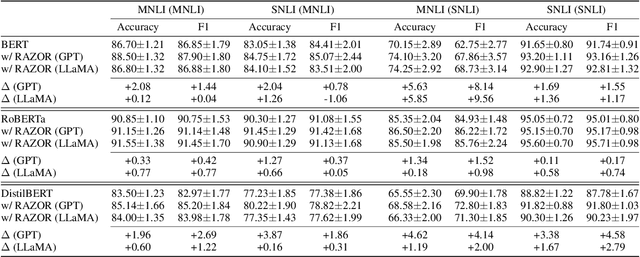
Abstract:Despite the widespread use of LLMs due to their superior performance in various tasks, their high computational costs often lead potential users to opt for the pretraining-finetuning pipeline. However, biases prevalent in manually constructed datasets can introduce spurious correlations between tokens and labels, creating so-called shortcuts and hindering the generalizability of fine-tuned models. Existing debiasing methods often rely on prior knowledge of specific dataset biases, which is challenging to acquire a priori. We propose RAZOR (Rewriting And Zero-bias Optimization Refinement), a novel, unsupervised, and data-focused debiasing approach based on text rewriting for shortcut mitigation. RAZOR leverages LLMs to iteratively rewrite potentially biased text segments by replacing them with heuristically selected alternatives in a shortcut space defined by token statistics and positional information. This process aims to align surface-level text features more closely with diverse label distributions, thereby promoting the learning of genuine linguistic patterns. Compared with unsupervised SoTA models, RAZOR improves by 3.5% on the FEVER and 6.5% on MNLI and SNLI datasets according to the F1 score. Additionally, RAZOR effectively mitigates specific known biases, reducing bias-related terms by x2 without requiring prior bias information, a result that is on par with SoTA models that leverage prior information. Our work prioritizes data manipulation over architectural modifications, emphasizing the pivotal role of data quality in enhancing model performance and fairness. This research contributes to developing more robust evaluation benchmarks for debiasing methods by incorporating metrics for bias reduction and overall model efficacy.
Seamless Monitoring of Stress Levels Leveraging a Universal Model for Time Sequences
Jul 04, 2024



Abstract:Monitoring the stress level in patients with neurodegenerative diseases can help manage symptoms, improve patient's quality of life, and provide insight into disease progression. In the literature, ECG, actigraphy, speech, voice, and facial analysis have proven effective at detecting patients' emotions. On the other hand, these tools are invasive and do not integrate smoothly into the patient's daily life. HRV has also been proven to effectively indicate stress conditions, especially in combination with other signals. However, when HRV is derived from less invasive devices than the ECG, like smartwatches and bracelets, the quality of measurements significantly degrades. This paper presents a methodology for stress detection from a smartwatch based on a universal model for time series, UniTS, which we fine-tuned for the task. We cast the problem as anomaly detection rather than classification to favor model adaptation to individual patients and allow the clinician to maintain greater control over the system's predictions. We demonstrate that our proposed model considerably surpasses 12 top-performing methods on 3 benchmark datasets. Furthermore, unlike other state-of-the-art systems, UniTS enables seamless monitoring, as it shows comparable performance when using signals from invasive or lightweight devices.
Towards Non-Adversarial Algorithmic Recourse
Mar 15, 2024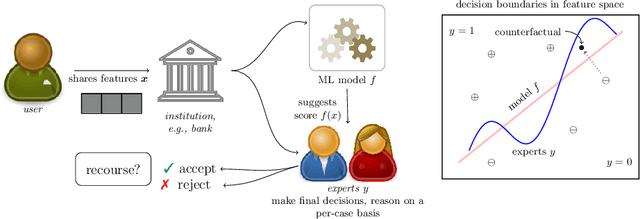
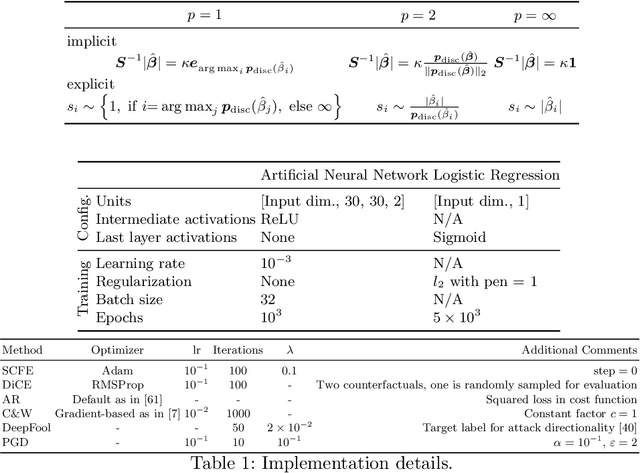
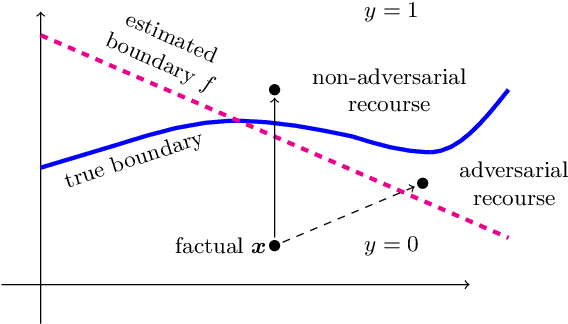
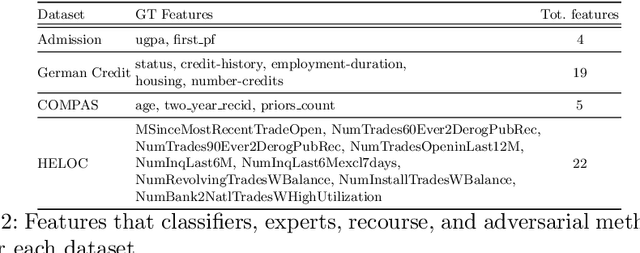
Abstract:The streams of research on adversarial examples and counterfactual explanations have largely been growing independently. This has led to several recent works trying to elucidate their similarities and differences. Most prominently, it has been argued that adversarial examples, as opposed to counterfactual explanations, have a unique characteristic in that they lead to a misclassification compared to the ground truth. However, the computational goals and methodologies employed in existing counterfactual explanation and adversarial example generation methods often lack alignment with this requirement. Using formal definitions of adversarial examples and counterfactual explanations, we introduce non-adversarial algorithmic recourse and outline why in high-stakes situations, it is imperative to obtain counterfactual explanations that do not exhibit adversarial characteristics. We subsequently investigate how different components in the objective functions, e.g., the machine learning model or cost function used to measure distance, determine whether the outcome can be considered an adversarial example or not. Our experiments on common datasets highlight that these design choices are often more critical in deciding whether recourse is non-adversarial than whether recourse or attack algorithms are used. Furthermore, we show that choosing a robust and accurate machine learning model results in less adversarial recourse desired in practice.
Robust Stochastic Graph Generator for Counterfactual Explanations
Dec 18, 2023



Abstract:Counterfactual Explanation (CE) techniques have garnered attention as a means to provide insights to the users engaging with AI systems. While extensively researched in domains such as medical imaging and autonomous vehicles, Graph Counterfactual Explanation (GCE) methods have been comparatively under-explored. GCEs generate a new graph similar to the original one, with a different outcome grounded on the underlying predictive model. Among these GCE techniques, those rooted in generative mechanisms have received relatively limited investigation despite demonstrating impressive accomplishments in other domains, such as artistic styles and natural language modelling. The preference for generative explainers stems from their capacity to generate counterfactual instances during inference, leveraging autonomously acquired perturbations of the input graph. Motivated by the rationales above, our study introduces RSGG-CE, a novel Robust Stochastic Graph Generator for Counterfactual Explanations able to produce counterfactual examples from the learned latent space considering a partially ordered generation sequence. Furthermore, we undertake quantitative and qualitative analyses to compare RSGG-CE's performance against SoA generative explainers, highlighting its increased ability to engendering plausible counterfactual candidates.
Adapting to Change: Robust Counterfactual Explanations in Dynamic Data Landscapes
Aug 04, 2023


Abstract:We introduce a novel semi-supervised Graph Counterfactual Explainer (GCE) methodology, Dynamic GRAph Counterfactual Explainer (DyGRACE). It leverages initial knowledge about the data distribution to search for valid counterfactuals while avoiding using information from potentially outdated decision functions in subsequent time steps. Employing two graph autoencoders (GAEs), DyGRACE learns the representation of each class in a binary classification scenario. The GAEs minimise the reconstruction error between the original graph and its learned representation during training. The method involves (i) optimising a parametric density function (implemented as a logistic regression function) to identify counterfactuals by maximising the factual autoencoder's reconstruction error, (ii) minimising the counterfactual autoencoder's error, and (iii) maximising the similarity between the factual and counterfactual graphs. This semi-supervised approach is independent of an underlying black-box oracle. A logistic regression model is trained on a set of graph pairs to learn weights that aid in finding counterfactuals. At inference, for each unseen graph, the logistic regressor identifies the best counterfactual candidate using these learned weights, while the GAEs can be iteratively updated to represent the continual adaptation of the learned graph representation over iterations. DyGRACE is quite effective and can act as a drift detector, identifying distributional drift based on differences in reconstruction errors between iterations. It avoids reliance on the oracle's predictions in successive iterations, thereby increasing the efficiency of counterfactual discovery. DyGRACE, with its capacity for contrastive learning and drift detection, will offer new avenues for semi-supervised learning and explanation generation.
Multimodal Motion Conditioned Diffusion Model for Skeleton-based Video Anomaly Detection
Jul 14, 2023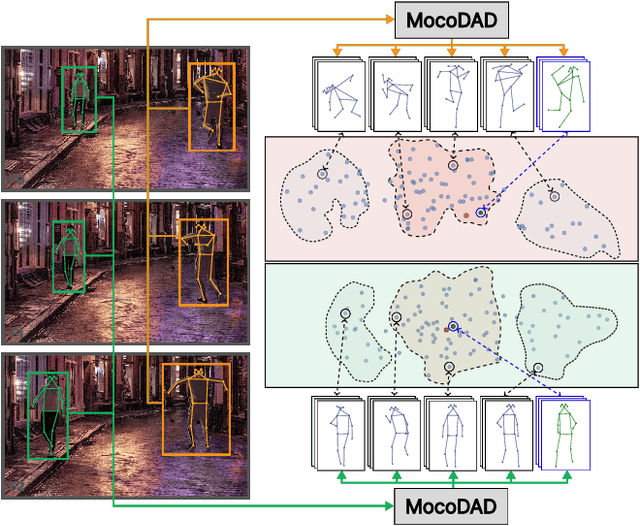
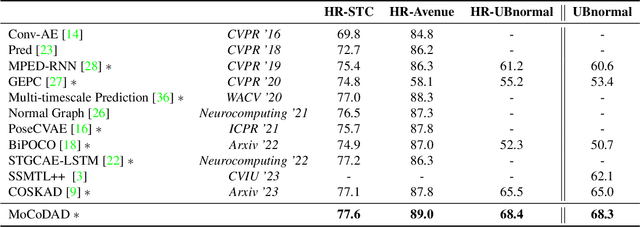
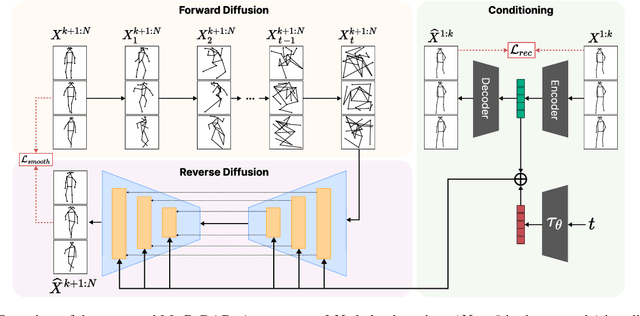
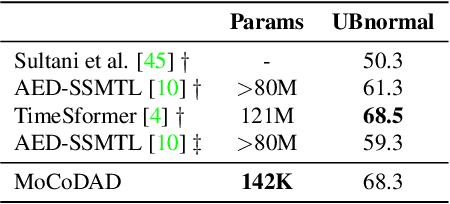
Abstract:Anomalies are rare and anomaly detection is often therefore framed as One-Class Classification (OCC), i.e. trained solely on normalcy. Leading OCC techniques constrain the latent representations of normal motions to limited volumes and detect as abnormal anything outside, which accounts satisfactorily for the openset'ness of anomalies. But normalcy shares the same openset'ness property, since humans can perform the same action in several ways, which the leading techniques neglect. We propose a novel generative model for video anomaly detection (VAD), which assumes that both normality and abnormality are multimodal. We consider skeletal representations and leverage state-of-the-art diffusion probabilistic models to generate multimodal future human poses. We contribute a novel conditioning on the past motion of people, and exploit the improved mode coverage capabilities of diffusion processes to generate different-but-plausible future motions. Upon the statistical aggregation of future modes, anomaly is detected when the generated set of motions is not pertinent to the actual future. We validate our model on 4 established benchmarks: UBnormal, HR-UBnormal, HR-STC, and HR-Avenue, with extensive experiments surpassing state-of-the-art results.
 Add to Chrome
Add to Chrome Add to Firefox
Add to Firefox Add to Edge
Add to Edge